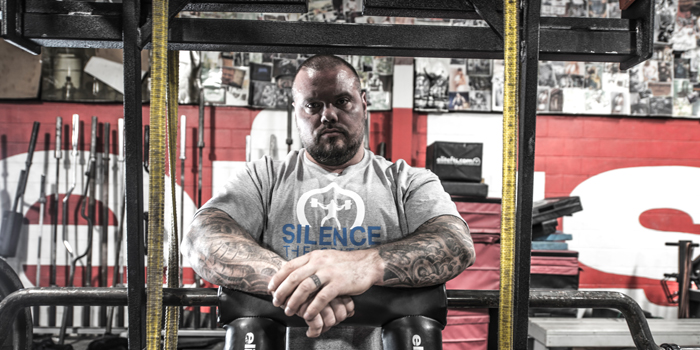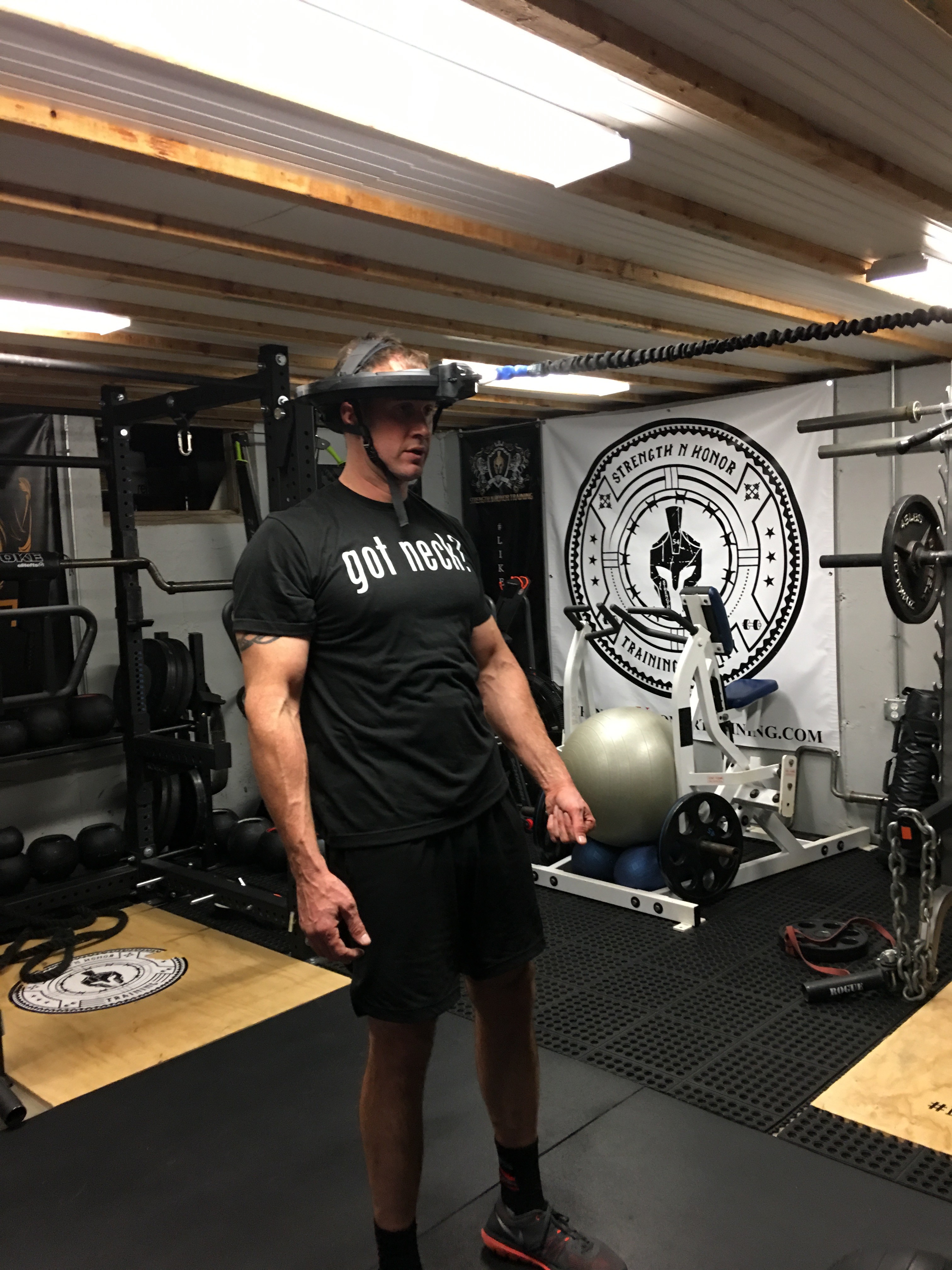
In Part 1 of my BAMF Wrestler series, I gave you a glimpse of a detailed year-round wrestling training program I’ve been developing with my friend, colleague, and Strength N Honor Training Facility’s head strength and athletic conditioning coach and owner Steve “Kono” Konopka. We talked about the challenges we’ve seen in modern wrestling programs, training frequency, and the importance of letting kids be kids.
In Part 2, Kono and I talked more in-depth about our in-season training goals, off-season exercises to avoid, recovery sessions, favorite exercises, and a sample in-season schedule.
In this installment, Kono and I cover our daily pre-practice warm-ups, bulletproof shoulder circuits, what we call the “f@#k the bottom, you belong at the top” conditioning circuit, and answer a couple of questions.
Daily Pre-Practice Warm-Up
KONO
My perfect pre-practice warm-up would take about 10 to 12 minutes, and I know some coaches will cringe at that, but the age of doing “some of these and some of those,” as Joe DeFranco always says, is over. Proper mobility and activation will help prevent injuries and once fully primed the athlete is more mentally focused and ready to attack the practice.
- Ankle / Calf Stretch
- Hip Flexor
- Seal Stretch
- Spider-Man
- Leg Spread Roll Back Roll Forward Reach
- Right Leg Over Left Knee Left Elbow Over Knee Looking Back Vice Versa
- Kneeling Thoracic Spine
- Shoulder Stretch
- Shoulder Circles
- Seal Claps
- Hip Circle Walks
CHRIS
For our warm-up/pre-practice/pre-lift routine, we take about 10 minutes to prep our body for what is coming up. Positives of this also can keep the body flexible and mobile and can help reduce and minimize the chances of injuries. Here is a sample of what we do:
Start with a light jog, and as we get into it, we add in between the jogs:
- Lunge with a Twist
- Frankenstein Kicks
- Jog
- Single-Leg Romanian Deadlift
- Knee Tuck / Heel Lift
- Jogs
- High Knees
- Butt Kicks
- Speed Skips
- Fast Feet
We do each of these for about 20 to 30 seconds and get this entire list done within six to eight minutes, more or less.
After this, we hit mobility work. A sample could be:
- Supine Scorpions
- Prone Scorpions
- Roll-Over-Into-V-Sit-Stretch
- Bird Dogs
- Inch Worms
We recently started to add some RPR into our warm-ups, which might add a few extra minutes.
Bulletproof Shoulder Circuit
KONO
I recommend this circuit three times a week before practice. We do it two times through with 30-second rests.
- Face Pulls: 1 X 20
- Pullaparts: 1 X 20
- 3D Pullaparts: 1 X 15
- Dead Hang: 1 time up to 60 seconds
- Over Hand Grip Dead Hangs: 1 rep up to a 60-second hold
On the hang, totally relax, blow your air out, and compress ribs downward. This is a great stretch for shoulders, lats, upper back, and lower back, along with working on your grip strength.
CHRIS
For our shoulder health, we delay a few movements.
- Wall W’s
- Wall Rotations
- Banded Int./Ext. Rotations
- Banded Pullaparts
- Banded Face Pulls
These are all done in a controlled manner for 10 to 15 reps.
We also do some RPR/body tempering/manual bow tie, if needed and/or if time allows.
Have had some great results with all of them.
F@#k the Bottom Circuit
KONO
This circuit is a finisher we use when we start to shift our training into the last four weeks before the season. It consists of four exercises, and we start with 15- to 30-second work bursts with 10- to 15-second rest periods. Pending on the athletes, we will start with 8/15 second rounds (so they will hit each exercise twice) and work our way up to 16/30 second rounds (hitting each exercise four times) with 10 seconds of rest before they move onto the next exercise. That brings us to a 3:1 work to rest ratio and total work equivalent of a full six-minute match with overtime and sudden death. Four athletes will pick a station to start and just keep rotating around until the rounds are complete.
The four exercises we like to use for this conditioning circuit are the following:
Week 1
- Monday: 20 seconds work; 15-second rest; 8 rounds
- Friday: 25 seconds work; 15-second rest; 8 rounds
Week 2
- Monday: 25 seconds work; 10-second rest; 10 rounds
- Friday: 30 seconds work; 10-second rest; 12 rounds
Week 3
- Monday: 30 seconds work; 10-second rest; 12 rounds
- Friday: 30 seconds work; 10-second rest; 16 rounds
Week 4
- Monday: 30 seconds work; 10-second rest; 16 rounds
- Friday: 30 seconds work; 10-second rest; 16 rounds
CHRIS
I am big on resistance training for supersets, especially as the wrestler gets closer to season or if they need to cut some pounds or the coach or kid tells me they need to get in better shape.
By resistance training, I am speaking about high incline treadmill sprints, sled pushes, band-resisted sprints, plate pushes, etc. I love to superset (SS) these in 10/20/30 second bursts.
I will run this until we have accomplished quite a few sets, and I feel like I have pushed the wrestler to the brink or further. Here are some samples/examples:
- Treadmill Sprint (15% incline 10-12 mph) 10 seconds (SS) Broad Jump x 5 Jumps. Repeat 10 sets consecutive.
- Prowler Push (no added weight) 10 seconds (SS) Jump Shrugs 10 seconds. Repeat 10 sets consecutively.
- Plate Pushes 10 seconds (SS) Donkey Kicks 10 seconds. Repeat 10 sets consecutively.
Again these are just examples, and the variety and combinations we can do are endless.
Q&A
What are some mistakes athletes can avoid with their training and their prep?
KONO
A few mistakes I see are wrestlers not being consistent with their programs. Sometimes I see athletes feeling good and wrestling well, so they slack a little. They take their foot off the gas pedal a little. Splurging on fast foods, skipping a few sessions, or a having few really late nights are different ways. These usually go hand-in-hand when a wrestler is out real late, pounds a 10-pack at Taco Bell, and sleeps in really late to catch up on sleep and misses a recovery or maintenance session. Not saying you need to be anti-social but get eight to nine hours of sleep, have only one taco if your weight is in check (though I would never recommend Taco Bell to an athlete), and never skip a session.
If you're run down or had a super hard tournament with long travel time, at the minimum, get in some stretching, foam roll, and some prehab band work in for hips, shoulders, and lower back. Just getting the blood flowing and joints moving with some light resistance will help facilitate the recovery process. Then once that is done, make the decision if hitting the weights is beneficial or you need to lay off a day.
Another big mistake I see is training without any rhyme or reason. Not having an in-season plan is basically planning to fail. Map out your sessions, record weights, and reps. Don’t just go in the weight room here and there and do some these and some of those. That is a quick way to get yourself hurt, and honestly, you’re just wasting your time.
Lastly, I hate seeing wrestlers short change their warm-ups or prep. It’s even worse when a wrestling coach can’t budget a small block of time into his or her practice. A properly thought out full body warm-up or activation with some shoulder and lower back strengthening sets can be done in eight to ten minutes! It seems so simple that it’s often overlooked. A consistent routine like this can really help keep injuries away.
CHRIS
One of the biggest (if not the biggest) is to not lift weights in-season. I literally just heard back from a local coach that none of his wrestlers “are supposed to lift weights in-seasons.” BLOWS MY MIND! My opinion on this is the same as one of the best coaches, Chris Doyle, has told me:
Chris! Good to hear from you. People are buying into the value of strength and conditioning in relation to performance and injury prevention. However, many still don’t understand the value of in-season training. It doesn’t matter how strong you are in August if you are not strong in November. The Big Ten Championship will be won in November. Maintaining strength in-season prevents injury and increases the ability to recover from the physical demands of the season. Teams that have a physical advantage win.
In my opinion, if you don’t train in-season, you shouldn’t lift in the off-season. In fact, just find something else to do. Maybe wrestling isn’t for you.
Another thing I notice is to stick with a smart and effective rep scheme according to and based off when your matches and tournaments are. You wouldn’t want to train a max-effort movement the day before a big match. Find out and plan accordingly. Get a calendar and set a great game plan that will help you succeed!
What are some exercises you have started using that maybe you didn’t utilize in the past?
KONO
I have been using bands more and more lately over the last two years. We have always utilized bands but the ease of transporting and the variety of exercises bands are a must for my athletes. For shoulder work and prehab stuff, I use to like using two-, three-, or five-pound dumbbells or small plates. But the bands are just a lot easier to use and program with they really allow the athlete to work a wide range of exercises. The bands are also more economical and definitely travel a lot easier. Wrestlers can buy a $12 band and keep it in their bag to be able to use at away meets, home, and school.
One exciting new tool we have been using is the Iron Neck. It’s only been out for a year or two now, maybe three years, but I can see this being a staple in every strength and conditioning room that’s serious about its athletes’ health and performance. Strengthening wrestlers’ necks was always a priority of ours as well as all of our athletes for that matter.

The Iron Neck allows us to strengthen their necks in all three planes: coronal, sagittal, and transverse. We are even using it in real sport specific movements while strengthening. It really is revolutionary right now. For such a small simple piece of equipment, the strength training and head injury prevention benefits are outstanding.
CHRIS
I did an RPR seminar at the University of Illinois with their strength and conditioning staff and was mind blown. I also had a Level 1 and 2 held at my facility that has added great benefits to my wrestlers and athletes and clients. I highly recommend if there is a seminar close to you, attend and learn. They are definitely game changers. RPR doesn’t take away your current program or template; it just adds to it and complements it.
Also, I had Donnie Thompson in for a body-tempering seminar and learned a ton as well. We currently utilize body-tempering daily for recovery and to avoid injuries. Donnie has a boatload of videos up, so start learning.
I also like bands as Kono described. I have our wrestlers grab an ankle band and do lateral walks, focusing on great wrestling stance. Hand placements up as your coach wants you to. They must keep their feet far apart on every lateral step.
Do you have set time duration for in-season training or do you say this is the workload get through it and then you guys are out of here?
KONO
I have most of my wrestlers in a small private session where I am with them each set and rep, so the time management is easier to control compared to some of the teams using my TrainHeroic app, and they hit the workout on their own or with the wrestling coach. In a perfect world, I would like the strength training to be done in 35 minutes but no longer than 45 minutes tops. If they are in the weight room longer than that in-season, they’re goofing off or doing way too much. Get in, hit it HARD, hit it correctly, get out, and go recover.
Wrestling is so demanding, so the more efficiently the wrestler can practice and train, the more time they have to unwind, recover, and take care of school work. It all comes back to planning properly and being consistent.
CHRIS
For in-season workouts, I have to work with what I am given. Some have an hour or more and three to five days a week to train, and some have tournaments and duals consecutive so getting even a 30-minute one time per week training session is tough. Plus, when you add some cutting large amounts of weight (which I disagree with) training becomes even more limited.
In a perfect world, I would like two to three times a week with each session lasting 45 to 60 minutes. This would be ideal but not always applicable. I can also have a plan going in to the training session and if more teaching is needed, I don’t want to cut them when the session is scheduled to end, and likewise, I wouldn’t want to just use a filler to eat up some extra time if the wrestler got done with what was scheduled.
Stay tuned for #BAMFW Part 4, where we will cover:
- Post-match recovery
- Supplement suggestions
- Refueling tricks
Steve “Kono” Konopka can be emailed at strengthnhonorgym@gmail.com, and Chris Janek can be emailed at tankstrainingfacility@yahoo.com. They are also available on social media outlets at Strengthnhonortraining and tankstrainingfacility, respectively.










